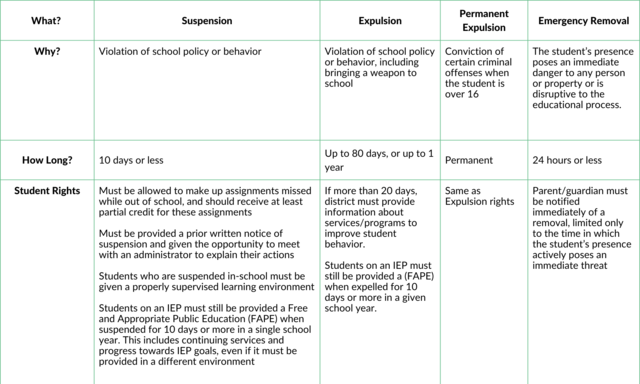Suspension, Expulsion, and Emergency Removal
March 14, 2023 by Chloe Palmer / special education
Suspension, Expulsion, and Emergency Removal - what’s the difference?
School discipline and student safety are top priorities for any school district. Students may be removed from school for a variety of reasons. The different removal types can impact student’s education in a variety of ways, particularly for special education students.
If you are asked to pick your student up from school for behavioral problems, it is important that the school clarifies in writing if the student is being suspended, expelled, or subject to an emergency removal. School removals can trigger procedural safeguards for students with disabilities, so knowing the difference is critical.

How are suspension/expulsion different for students in special education?
If a student on an IEP or a student with a disability protected by Section 504 of the Rehabilitation Act is suspended:
1. more than 10 school days in a row, or
2. for more than 10 school days in a single school year if the behaviors that led to the suspension are substantially similar ,
then the district must hold a manifestation determination review (MDR). At the MDR, the IEP team should decide if the student’s behaviors are substantially related to the student’s disability, due to the student’s disability, or due to the district not properly implementing the student’s IEP. If any of these factors are met, then the school cannot remove the student from school for more than 10 days. The school must instead amend the IEP or develop a behavior plan to support the student in school. For more information on manifestation determination reviews, see Disability Rights Ohio’s MDR Blog here.
What if I believe my student was improperly suspended, expelled, or removed?
When a student is suspended or expelled, the district must give the student an opportunity to appear at an informal hearing before the principal, assistant principal, superintendent, or superintendent’s designee. The student may use this hearing to challenge the reason for the suspension/expulsion or explain their actions.
If you believe the district violated special education law by not having a manifestation determination review, or by having an improper manifestation determination review, you have several options to resolve the dispute. One option is filing a complaint with the Ohio Department of Education (ODE). ODE has 60 days upon receiving a complaint to resolve the issue. You can access the ODE complaint form here.
Another option for resolving special education-related disputes is to file for expedited due process. This complaint procedure is specifically for disagreements about placements related to disciplinary removal or MDR’s. Once a complaint is filed the district and parent will have a resolution meeting within 7 calendar days (unless both agree to waive the meeting). Within 20 calendar days there will be a hearing with a hearing officer. This officer then has 10 school days to issue a decision on the dispute.
